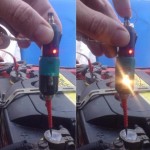How to assemble a test lamp electrician?
And although today there are already special indicator screwdrivers for checking the phase, as well as universal measuring devices, however, control lights are still appreciated and every electrician and car enthusiast has it. This is a simple and convenient device with which you can find out if there is voltage in the outlet, as well as determine which of the fuses in the car has failed, and to which pin on the connector comes 12 volts. Next, we will tell you how to make controls for 12 and 220 Volts with your own hands, providing visual photos, examples, diagrams and video instructions on which everyone can assemble this tool.
For home network
If you decide to make a control lamp for wiring checks and the presence of voltage in the house for a household electrical network, then all that is needed is:
- 220V bulb
- Electric cartridge.
- Two copper single-core wires 50 cm long each.
- Probes for ease of use control.
- Protective cover for the bulb.
So, all you need to do is connect the wires to the cartridge and screw the lamp into it. As you already understood, the home-made control lamp for 220 Volts has a fairly simple design, which allows you to assemble it with your own hands even to an inexperienced electrician.
To make it convenient to use the control, it is recommended to additionally connect the ends of each wire to the probes, which will be much easier to use if necessary check the voltage at the outlet. You can make such probes in various ways. For example, from the body of a ballpoint pen and a piece of thick single-core copper wire or nail. It is imperative to insulate the probes well, as even a small exposed area in the wrong place can lead to electric shock.
It is also recommended to additionally protect the incandescent lamp with a casing, whether it is protection made of wire or a transparent plastic cap of a suitable size. The lamp must be protected because it is often used during measurements and rough handling. Modern LED bulbs are practically devoid of this drawback, because they are protected by a durable plastic dome, and a casing is not required for them.
Photo examples of several home-made options from a light bulb and two wires you can see below:
In addition, we advise you to watch a video master class on assembling an electrician warning lamp:
For auto
If you want to independently make a control at 12 Volts for a car, we recommend using the following scheme:

In this example, VD1 and VD2 are LEDs that will signal the direction of current in the circuit. For greater clarity, you can take them in different colors and make designations on the case. HL1 is a regular bulb with a power of 1.2 W and a voltage of 12 volts, which simply shows the presence of voltage between the terminals of the control lamp, as in the 220-volt circuit. Verification with its help is carried out by pressing the button, which is also indicated on the diagram.As a probe, the author of the diode control lamp used a conventional wood screw, it can be replaced with any convenient nail or piece of wire. It is recommended to take a stranded wire, because it is flexible and will not be damaged so quickly during operation. Unlike the control on 220v, the homemade car should be equipped with a wire, about 2 meters long, so that it can be measured even in the car or under it. A small crocodile should be installed on the free end of the wire, with it you can connect to the mass in almost any part of the machine, which is very convenient. Well, the last thing to note - to make the device neat, use a cigarette lighter plug, which will be an excellent body for a warning light.
You can see the tool for auto electrician on 12v in the following photo examples:
In addition, we recommend watching a video in which a specialist demonstrates some of the most popular types of warning lights for cars (12 and even 24 V), which you can do with your own hands:
That's all I wanted to tell you about how to do the control on 12 and 220 Volts with your own hands! We hope that the scheme was understandable, and you can easily assemble this extremely useful and simple device yourself.
It will be interesting to read:
















I have made such control from a signal LED lamp, which I use in electrical panels. They are different in color (I have a little red one) and the main plus is that it does not crumble and will not break)